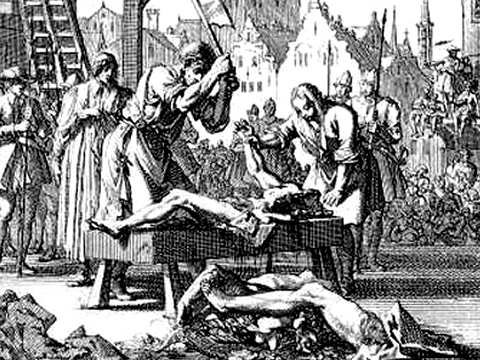 Amid medieval times, the punishment for high treachery in England was to be hanged, attracted and quartered open and however it was annulled in 1814, it has been in charge of the passing of a great many individuals. In this torment procedure, the casualty is dragged in a wooden edge called an obstacle to the spot of execution. They would then be hanged by the neck for a brief timeframe until they are close passing (hanged), trailed by gutting and maiming where the guts and genitalia are smoldered before the casualty (drawn). The casualty would then be isolated into four separate parts and decapitated (quartered).To be hanged, drawn and quartered was from 1351 a statutory penalty in England for men convicted of high treason, although the ritual was first recorded during the reign of King Henry III (1216–1272). Convicts were fastened to a hurdle, or wooden panel, and drawn by horse to the place of execution, where they were hanged (almost to the point of death), emasculated, disembowelled, beheaded and quartered (chopped into four pieces). Their remains were often displayed in prominent places across the country, such as London Bridge. For reasons of public decency, women convicted of high treason were instead burned at the stake.
Amid medieval times, the punishment for high treachery in England was to be hanged, attracted and quartered open and however it was annulled in 1814, it has been in charge of the passing of a great many individuals. In this torment procedure, the casualty is dragged in a wooden edge called an obstacle to the spot of execution. They would then be hanged by the neck for a brief timeframe until they are close passing (hanged), trailed by gutting and maiming where the guts and genitalia are smoldered before the casualty (drawn). The casualty would then be isolated into four separate parts and decapitated (quartered).To be hanged, drawn and quartered was from 1351 a statutory penalty in England for men convicted of high treason, although the ritual was first recorded during the reign of King Henry III (1216–1272). Convicts were fastened to a hurdle, or wooden panel, and drawn by horse to the place of execution, where they were hanged (almost to the point of death), emasculated, disembowelled, beheaded and quartered (chopped into four pieces). Their remains were often displayed in prominent places across the country, such as London Bridge. For reasons of public decency, women convicted of high treason were instead burned at the stake.The severity of the sentence was measured against the seriousness of the crime. As an attack on the monarch's authority, high treason was considered a deplorable act demanding the most extreme form of punishment; although some convicts had their sentences modified and suffered a less ignominious end, over a period of several hundred years many men found guilty of high treason were subjected to the law's ultimate sanction. They included many English Catholic priests executed during the Elizabethan era, and several of the regicides involved in the 1649 execution of Charles I.
Although the Act of Parliament defining high treason remains on the United Kingdom's statute books, during a long period of 19th-century legal reform the sentence of hanging, drawing and quartering was changed to drawing, hanging until dead, and posthumous beheading and quartering, before being abolished in England in 1870. The death penalty for treason was abolished in
No comments:
Post a Comment